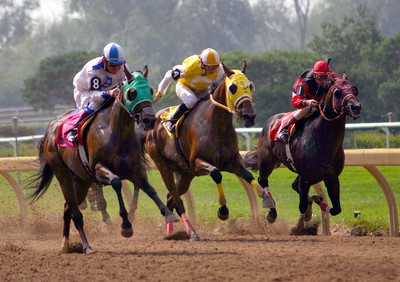 Doubles and trebles are the simplest forms of accumulator bets, featuring two and three legs (or selections) respectively. Many everyday, recreational punters love big accas because they can deliver massive returns even from small stakes. However, in general, they tend to be eschewed by the more serious bettor as they are usually likely to offer a wider profit margin to the bookie.
Doubles and trebles are the simplest forms of accumulator bets, featuring two and three legs (or selections) respectively. Many everyday, recreational punters love big accas because they can deliver massive returns even from small stakes. However, in general, they tend to be eschewed by the more serious bettor as they are usually likely to offer a wider profit margin to the bookie.
Doubles and trebles are often good halfway houses between wild 10-fold accas that might deliver odds of 100/1 or more and standard singles where often a large stake is required to generate a significant return. However, whilst betting on doubles and trebles is quite common, by both people who bet just for fun and, to a lesser extent, by professional gamblers, each way doubles and trebles are bets that are less frequently made. Here we explain how these bets work, how the each way part of the wagers are incorporated and what the payouts are.
Each Way Doubles

As with any double, to place an each way double you must pick two selections. For the sake of this example, let us imagine you are betting on the winners of the two biggest races at a particular horse racing meeting. Betting on the horses is huge, second only to football betting in the UK, and it is also the sport in which each way bets are most typically placed due to the nature of the contests, with fields of eight, 10, 16 or even more being perfectly normal.
Let us assume you decide that in both of the day’s feature contests the favourite can be taken on and so opt for the following picks:
- Simply Crackers @ 16/1 in the 2:40
- Mouse McMouseface @ 20/1 in the 3:10
Let’s say you place a £10 each way double and, as with all each way bets, this means you effectively have to front two stakes, so the bet costs a total of £20. Of that,£10 goes on the win half of the bet and £10 on the place. Let’s imagine that both races pay each way bets down to four places and at a quarter of the standard odds.
In order to win both parts of your bet, both horses must win. On the other hand, if either horse loses, even if the other should win, you will lose your entire stake. If both horses place, or one places and the other wins, you lose the win portion of the bet but are successful with the each way/place part. The table below shows the various possible outcomes.
| Race 1 Result | Race 2 Result | Winning Bet(s) | Total Profit |
|---|---|---|---|
| Won | Won | Win and each way bet win | £3,850 |
| Won | Placed | Win bet loses, place bet wins | £280 |
| Won | Unplaced | Lose both bets | Lose £20 stake |
| Placed | Won | Win bet loses, place bet wins | £280 |
| Placed | Placed | Win bet loses, place bet wins | £280 |
| Placed | Unplaced | Lose both bets | Lose £20 stake |
| Unplaced | Won | Lose both bets | Lose £20 stake |
| Unplaced | Placed | Lose both bets | Lose £20 stake |
| Unplaced | Unplaced | Lose both bets | Lose £20 stake |
If you are quite familiar with how each way bets work, how accas work and are also an experienced bettor, the table above might feel a bit like overkill. Our short summary above the table really explains all you need to know but sometimes people who are new to this type of wager can get a little confused.
This confusion tends to arise if one horse wins and one places. Sometimes punters feel they should get more than just the place payout, or that the odds of the horse that wins affect the payout. As the table above shows, this is not the case. The profit is the same whether both horses place or one wins and the other places, and it is also the same (as that and as each other) no matter which horse wins and which places. Should either horse fail to win then the maximum payout is capped at the each way part of the bet, whatever that may be.
Equally some punters may feel that if they got one leg of their double right, which is to say their horse won, they should get a return even if the other horse lost (which is to say neither won, nor placed). But this is a double and the result requires both legs to at least place. As such, if either leg fails to finish in the places, the entire bet is automatically downed.
What About A Dead Heat?

If one, or both legs of your bet end in a dead heat, be that for first place, or one of the places, dead heat rules are applied as normal. Dead heat rules can be a little confusing at times and we have a separate feature all about dead heats in horse racing so we will not go into all that much detail here. Dead heat rules are not complex but unless you are familiar with them, they are even more likely to perplex when they relate to each way bets. As such, if you are unsure about a dead heat in your each way double or treble we strongly advise reading the aforementioned article.
That said, if you are relatively familiar with these rules, which are an industry standard (and so applied in the same way by all bookies), then you should have no problem. In our example above, if, for example, Simply Crackers was involved in a dead heat for first place with one other horse, the stake for the win part of the bet would be reduced to £5.
Because, however, the place part of the bet was not affected by the dead heat, that would pay out as normal, based on the full £10 bet and a quarter of the two sets of odds. As such, in this scenario, you would see a return of £2,085 and a profit of £2,065, rather than the £3,850 had it won outright.
Each Way Trebles

When it comes to each way trebles things are essentially the same as with each way doubles, but of course we now have three legs to consider rather than just two. Once again, to claim the full payout all three horses (or legs – all of what we have said applies no matter what sports and markets you have included in your double or treble) must win. If any lose (that is, they don’t finish in the places), both the win and each way wagers are losers.
Equally, should any horse only manage to place (rather than win), the win part of the bet cannot be successful and the maximum win will be that which comes from the place part of your treble. So if you have a winner at 100/1, a winner at 50/1 and a place at evens, you will only win the each way bet, despite your glorious long-odds winners.
Each Way Double And Treble Strategy

We should note that no staking plan, betting strategy, or secret scheme can turn bad bets into good ones. By that, we mean that if a bet is bad value (which in betting terms means the odds are shorter than the probability of success would imply), there is no miracle system that can make it good value.
That said, some betting ideas are better than others and some can serve a useful purpose. In the case of each way doubles and trebles we feel there is one “system” (we use the term very loosely) that may be of interest to those who like a flutter on the horses, or other sports for which each way bets are readily available. It will not guarantee that you profit but it might help in giving punters a reasonable chance of landing some big wins, a decent chance of making their money last a reasonable amount of time and a fair degree of excitement as races unfold.
Some advocates of each way doubles and trebles suggest that you look for races where there is a relatively clear favourite and a relatively clear second favourite. If, for example, there is a horse on offer at 4/5, another priced at 6/4 and the field is 4/1 bar, the second favourite could be a handy addition to an each way double or treble.
The theory is that it has a fair chance of winning if the favourite slips up, but because it is a relatively clear second favourite it should (should, that word so favoured by punters!) at least be able to manage a place. Backing a 6/4 shot each way is not something many punters opt for as it will deliver a loss unless it wins. However, as part of an each way double, the results can be rather pleasing.
Let’s imagine we place an each way double with one horse at 6/4 and another at 2/1. If you win the place part of your bet you will make a profit – albeit a rather modest one of 63p (based on a £10 each way double). If both manage to win then that profit soars to a very tidy £75.63. Of course, there is always a chance that one, or both, will finish outside the places. But with a little bit of luck or skill on behalf of the person making the bets, the hope is that the times when both horses win will outweigh the losses when this occurs. And of course, in our example the loss is £20 whilst the potential profit is £75.63, so you have a little room for manoeuvre.
As said, this is no recipe for buying that yacht you have been eyeing up. However, at the very least, backing relatively short-priced horses each way should keep you interested in most races.
